Strategic Management of Vodafone NZ: Analysis and Recommendations
VerifiedAdded on 2023/06/11
|12
|2250
|284
Report
AI Summary
This report provides a strategic analysis of Vodafone New Zealand, a multinational telecommunications company operating in New Zealand. It includes an external environment analysis based on the telecommunications market using PEST, and an internal analysis using the SWOT framework. The report evaluates strategic options for Vodafone, considering its strengths and weaknesses, and offers recommendations for future operations. It highlights Vodafone's market position, competitive challenges, and opportunities for growth in the New Zealand telecommunications sector. The report concludes with actionable recommendations aimed at enhancing Vodafone's revenues and profitability amidst increasing competition. Desklib provides access to similar reports and study tools for students.
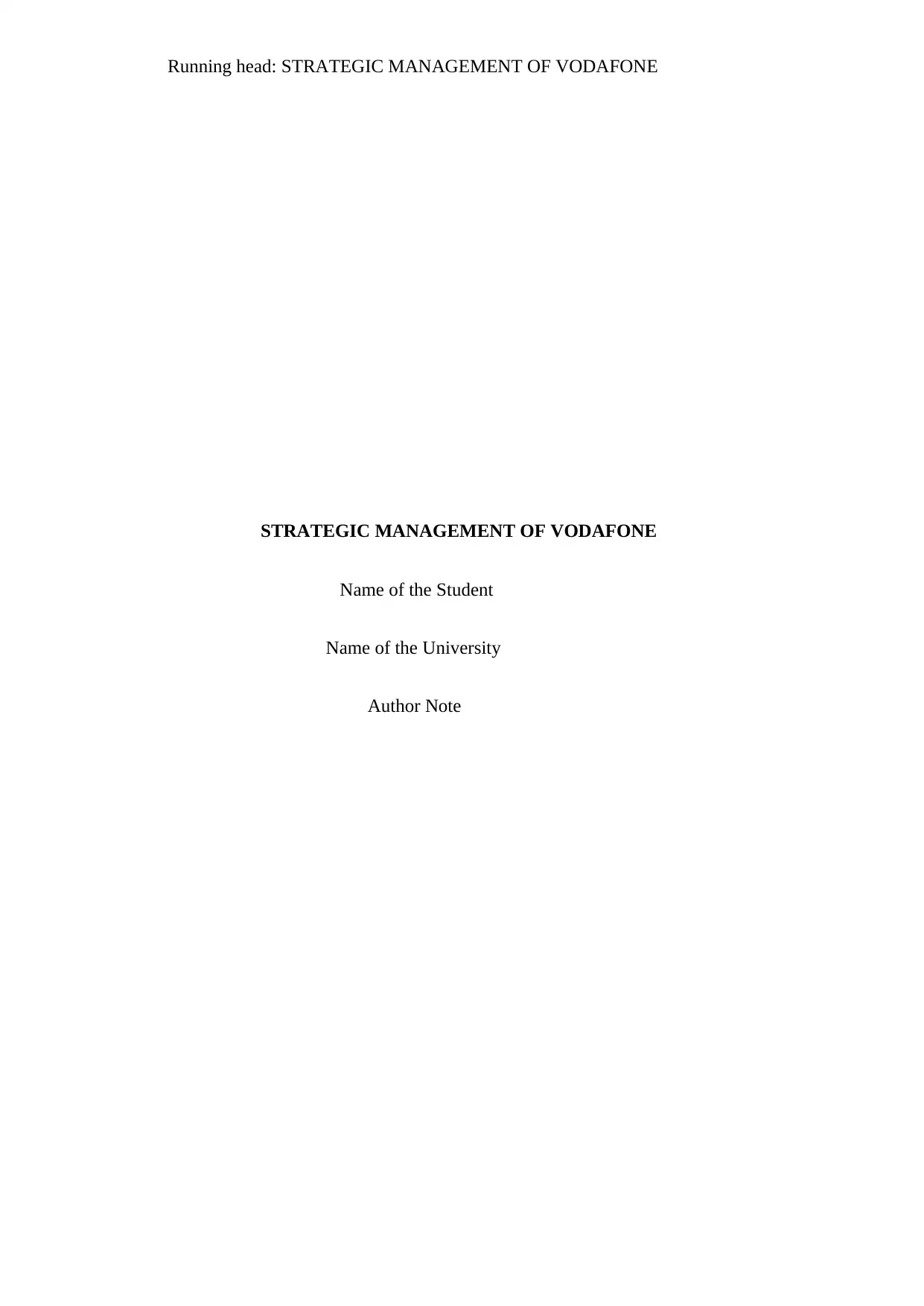
Running head: STRATEGIC MANAGEMENT OF VODAFONE
STRATEGIC MANAGEMENT OF VODAFONE
Name of the Student
Name of the University
Author Note
STRATEGIC MANAGEMENT OF VODAFONE
Name of the Student
Name of the University
Author Note
Paraphrase This Document
Need a fresh take? Get an instant paraphrase of this document with our AI Paraphraser
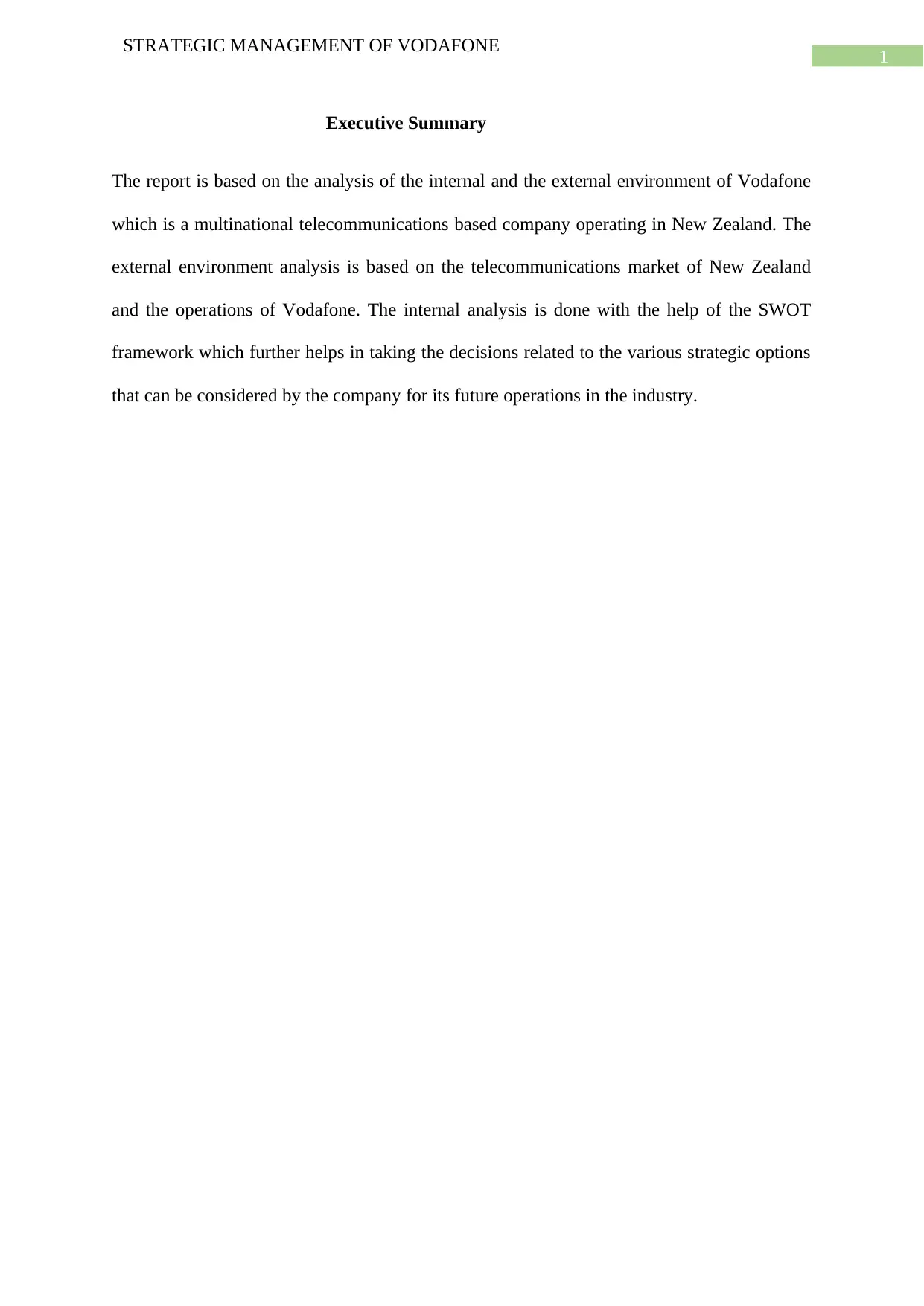
1
STRATEGIC MANAGEMENT OF VODAFONE
Executive Summary
The report is based on the analysis of the internal and the external environment of Vodafone
which is a multinational telecommunications based company operating in New Zealand. The
external environment analysis is based on the telecommunications market of New Zealand
and the operations of Vodafone. The internal analysis is done with the help of the SWOT
framework which further helps in taking the decisions related to the various strategic options
that can be considered by the company for its future operations in the industry.
STRATEGIC MANAGEMENT OF VODAFONE
Executive Summary
The report is based on the analysis of the internal and the external environment of Vodafone
which is a multinational telecommunications based company operating in New Zealand. The
external environment analysis is based on the telecommunications market of New Zealand
and the operations of Vodafone. The internal analysis is done with the help of the SWOT
framework which further helps in taking the decisions related to the various strategic options
that can be considered by the company for its future operations in the industry.
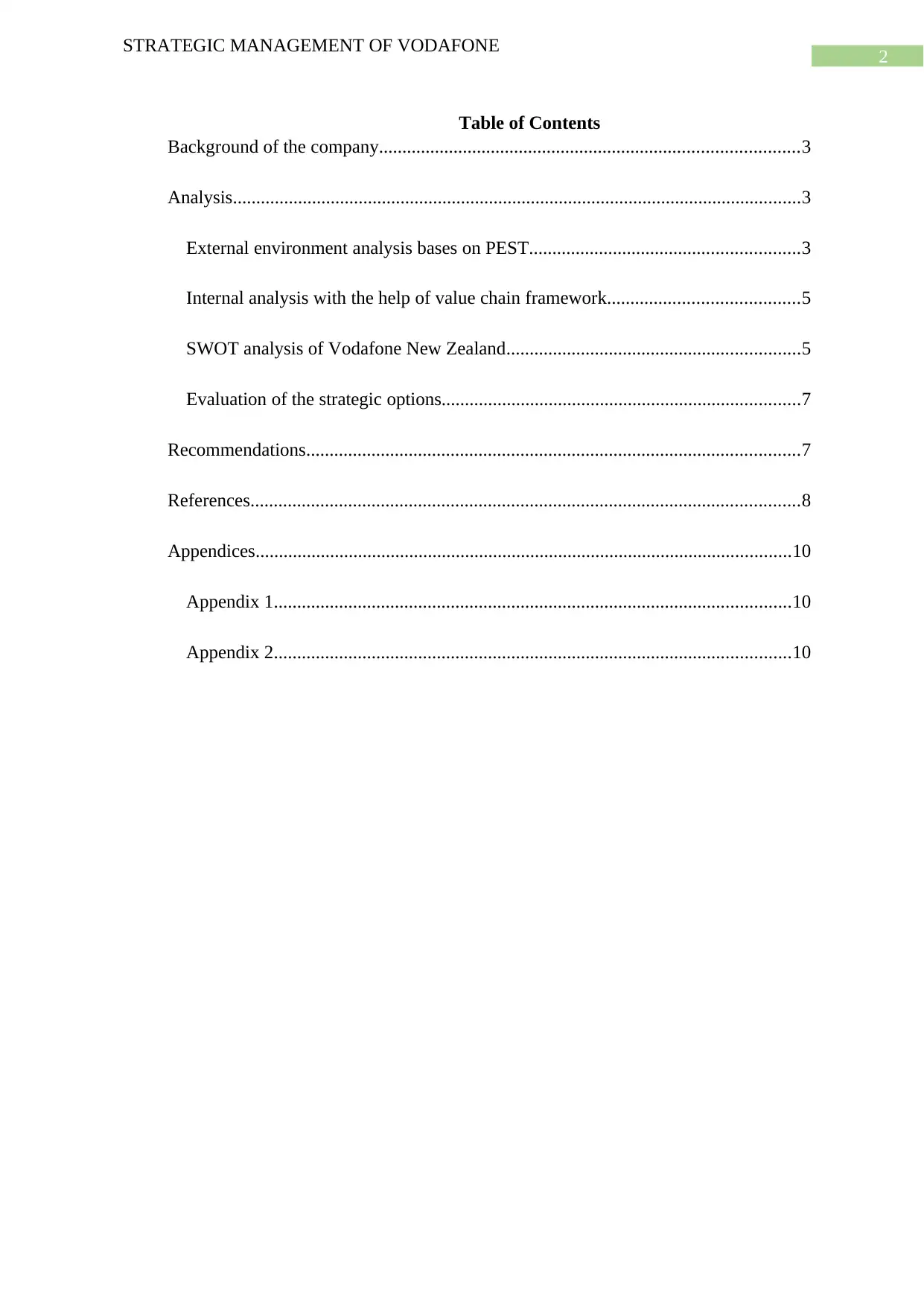
2
STRATEGIC MANAGEMENT OF VODAFONE
Table of Contents
Background of the company..........................................................................................3
Analysis..........................................................................................................................3
External environment analysis bases on PEST..........................................................3
Internal analysis with the help of value chain framework.........................................5
SWOT analysis of Vodafone New Zealand...............................................................5
Evaluation of the strategic options.............................................................................7
Recommendations..........................................................................................................7
References......................................................................................................................8
Appendices...................................................................................................................10
Appendix 1...............................................................................................................10
Appendix 2...............................................................................................................10
STRATEGIC MANAGEMENT OF VODAFONE
Table of Contents
Background of the company..........................................................................................3
Analysis..........................................................................................................................3
External environment analysis bases on PEST..........................................................3
Internal analysis with the help of value chain framework.........................................5
SWOT analysis of Vodafone New Zealand...............................................................5
Evaluation of the strategic options.............................................................................7
Recommendations..........................................................................................................7
References......................................................................................................................8
Appendices...................................................................................................................10
Appendix 1...............................................................................................................10
Appendix 2...............................................................................................................10
⊘ This is a preview!⊘
Do you want full access?
Subscribe today to unlock all pages.

Trusted by 1+ million students worldwide
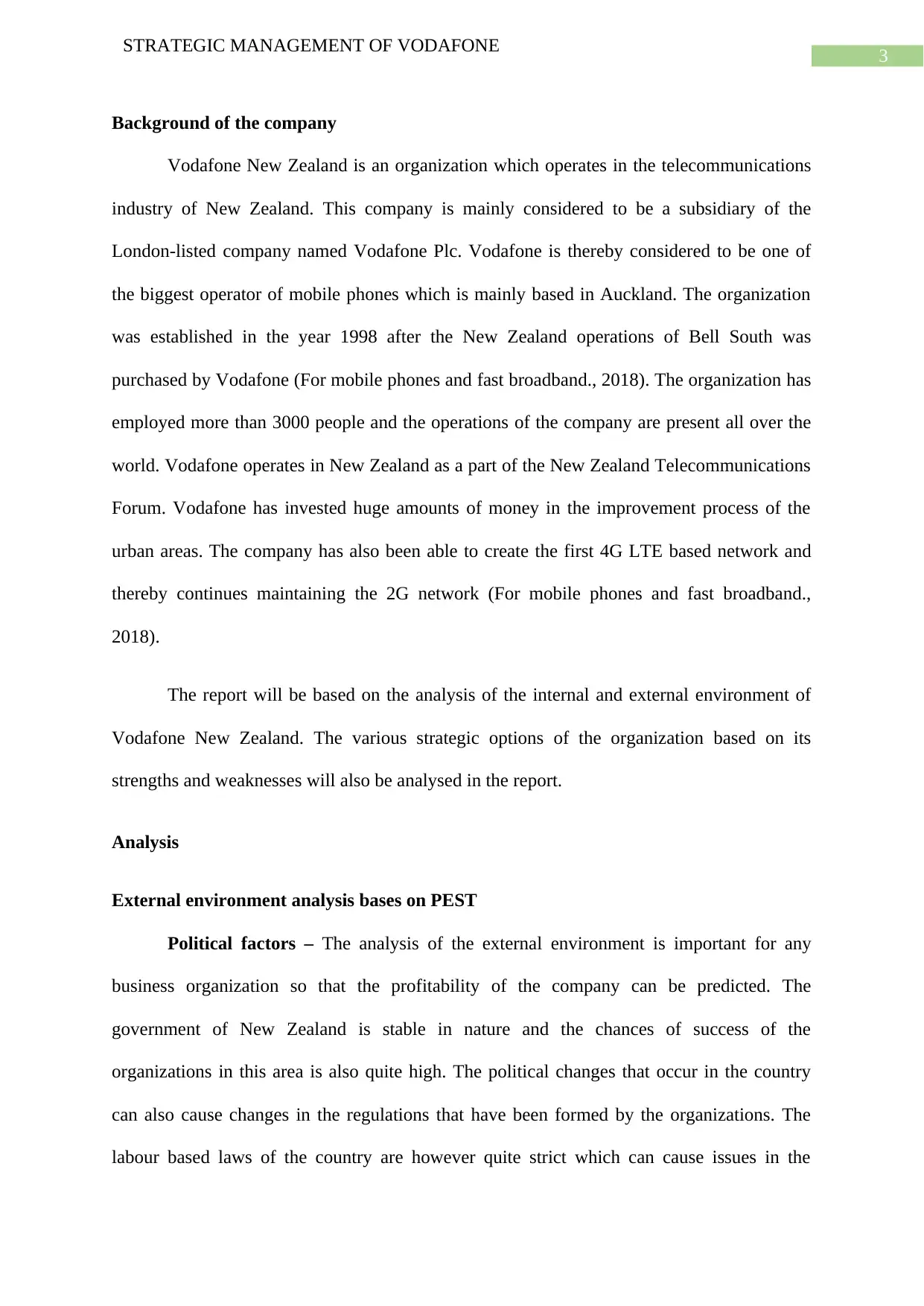
3
STRATEGIC MANAGEMENT OF VODAFONE
Background of the company
Vodafone New Zealand is an organization which operates in the telecommunications
industry of New Zealand. This company is mainly considered to be a subsidiary of the
London-listed company named Vodafone Plc. Vodafone is thereby considered to be one of
the biggest operator of mobile phones which is mainly based in Auckland. The organization
was established in the year 1998 after the New Zealand operations of Bell South was
purchased by Vodafone (For mobile phones and fast broadband., 2018). The organization has
employed more than 3000 people and the operations of the company are present all over the
world. Vodafone operates in New Zealand as a part of the New Zealand Telecommunications
Forum. Vodafone has invested huge amounts of money in the improvement process of the
urban areas. The company has also been able to create the first 4G LTE based network and
thereby continues maintaining the 2G network (For mobile phones and fast broadband.,
2018).
The report will be based on the analysis of the internal and external environment of
Vodafone New Zealand. The various strategic options of the organization based on its
strengths and weaknesses will also be analysed in the report.
Analysis
External environment analysis bases on PEST
Political factors – The analysis of the external environment is important for any
business organization so that the profitability of the company can be predicted. The
government of New Zealand is stable in nature and the chances of success of the
organizations in this area is also quite high. The political changes that occur in the country
can also cause changes in the regulations that have been formed by the organizations. The
labour based laws of the country are however quite strict which can cause issues in the
STRATEGIC MANAGEMENT OF VODAFONE
Background of the company
Vodafone New Zealand is an organization which operates in the telecommunications
industry of New Zealand. This company is mainly considered to be a subsidiary of the
London-listed company named Vodafone Plc. Vodafone is thereby considered to be one of
the biggest operator of mobile phones which is mainly based in Auckland. The organization
was established in the year 1998 after the New Zealand operations of Bell South was
purchased by Vodafone (For mobile phones and fast broadband., 2018). The organization has
employed more than 3000 people and the operations of the company are present all over the
world. Vodafone operates in New Zealand as a part of the New Zealand Telecommunications
Forum. Vodafone has invested huge amounts of money in the improvement process of the
urban areas. The company has also been able to create the first 4G LTE based network and
thereby continues maintaining the 2G network (For mobile phones and fast broadband.,
2018).
The report will be based on the analysis of the internal and external environment of
Vodafone New Zealand. The various strategic options of the organization based on its
strengths and weaknesses will also be analysed in the report.
Analysis
External environment analysis bases on PEST
Political factors – The analysis of the external environment is important for any
business organization so that the profitability of the company can be predicted. The
government of New Zealand is stable in nature and the chances of success of the
organizations in this area is also quite high. The political changes that occur in the country
can also cause changes in the regulations that have been formed by the organizations. The
labour based laws of the country are however quite strict which can cause issues in the
Paraphrase This Document
Need a fresh take? Get an instant paraphrase of this document with our AI Paraphraser
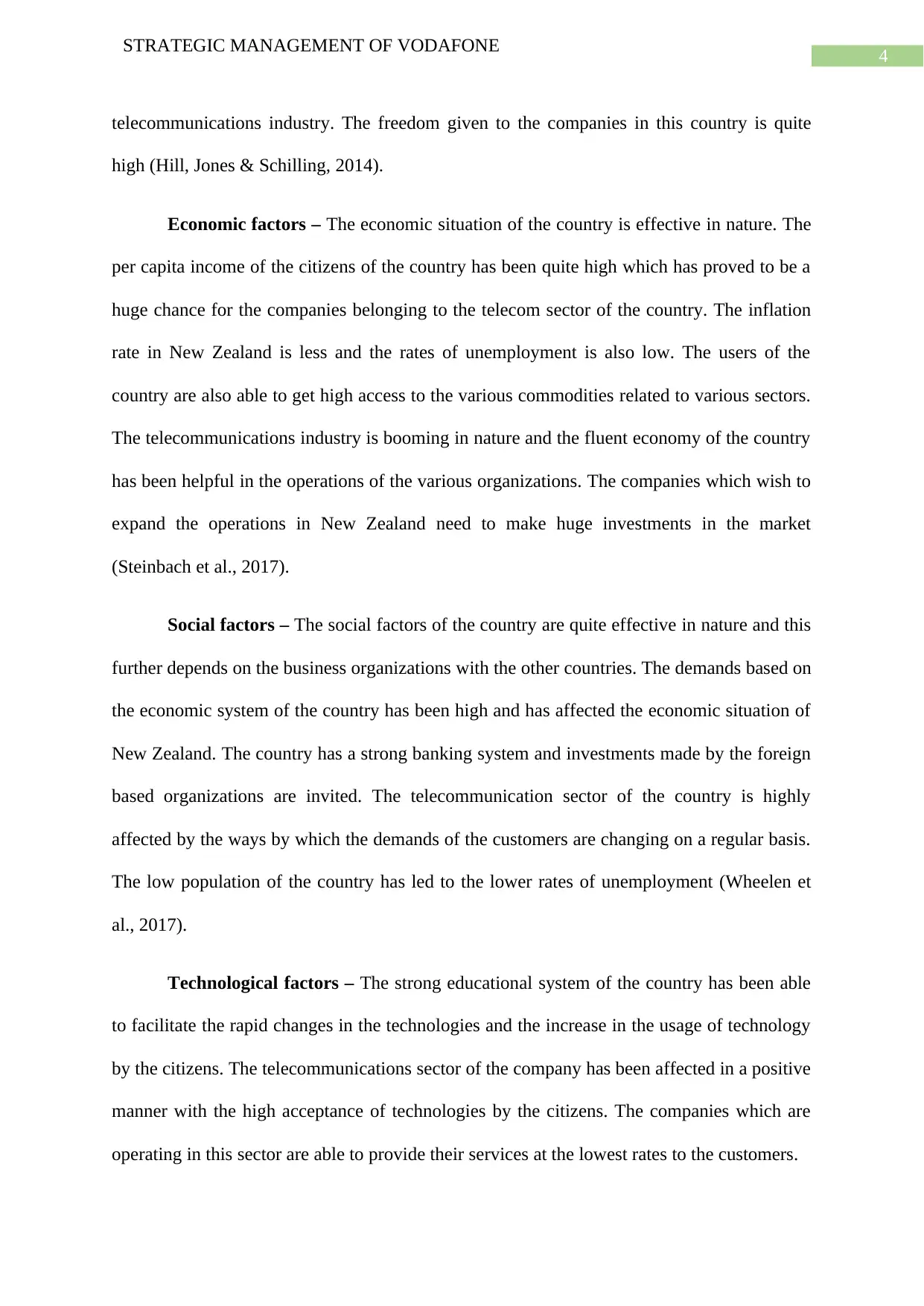
4
STRATEGIC MANAGEMENT OF VODAFONE
telecommunications industry. The freedom given to the companies in this country is quite
high (Hill, Jones & Schilling, 2014).
Economic factors – The economic situation of the country is effective in nature. The
per capita income of the citizens of the country has been quite high which has proved to be a
huge chance for the companies belonging to the telecom sector of the country. The inflation
rate in New Zealand is less and the rates of unemployment is also low. The users of the
country are also able to get high access to the various commodities related to various sectors.
The telecommunications industry is booming in nature and the fluent economy of the country
has been helpful in the operations of the various organizations. The companies which wish to
expand the operations in New Zealand need to make huge investments in the market
(Steinbach et al., 2017).
Social factors – The social factors of the country are quite effective in nature and this
further depends on the business organizations with the other countries. The demands based on
the economic system of the country has been high and has affected the economic situation of
New Zealand. The country has a strong banking system and investments made by the foreign
based organizations are invited. The telecommunication sector of the country is highly
affected by the ways by which the demands of the customers are changing on a regular basis.
The low population of the country has led to the lower rates of unemployment (Wheelen et
al., 2017).
Technological factors – The strong educational system of the country has been able
to facilitate the rapid changes in the technologies and the increase in the usage of technology
by the citizens. The telecommunications sector of the company has been affected in a positive
manner with the high acceptance of technologies by the citizens. The companies which are
operating in this sector are able to provide their services at the lowest rates to the customers.
STRATEGIC MANAGEMENT OF VODAFONE
telecommunications industry. The freedom given to the companies in this country is quite
high (Hill, Jones & Schilling, 2014).
Economic factors – The economic situation of the country is effective in nature. The
per capita income of the citizens of the country has been quite high which has proved to be a
huge chance for the companies belonging to the telecom sector of the country. The inflation
rate in New Zealand is less and the rates of unemployment is also low. The users of the
country are also able to get high access to the various commodities related to various sectors.
The telecommunications industry is booming in nature and the fluent economy of the country
has been helpful in the operations of the various organizations. The companies which wish to
expand the operations in New Zealand need to make huge investments in the market
(Steinbach et al., 2017).
Social factors – The social factors of the country are quite effective in nature and this
further depends on the business organizations with the other countries. The demands based on
the economic system of the country has been high and has affected the economic situation of
New Zealand. The country has a strong banking system and investments made by the foreign
based organizations are invited. The telecommunication sector of the country is highly
affected by the ways by which the demands of the customers are changing on a regular basis.
The low population of the country has led to the lower rates of unemployment (Wheelen et
al., 2017).
Technological factors – The strong educational system of the country has been able
to facilitate the rapid changes in the technologies and the increase in the usage of technology
by the citizens. The telecommunications sector of the company has been affected in a positive
manner with the high acceptance of technologies by the citizens. The companies which are
operating in this sector are able to provide their services at the lowest rates to the customers.
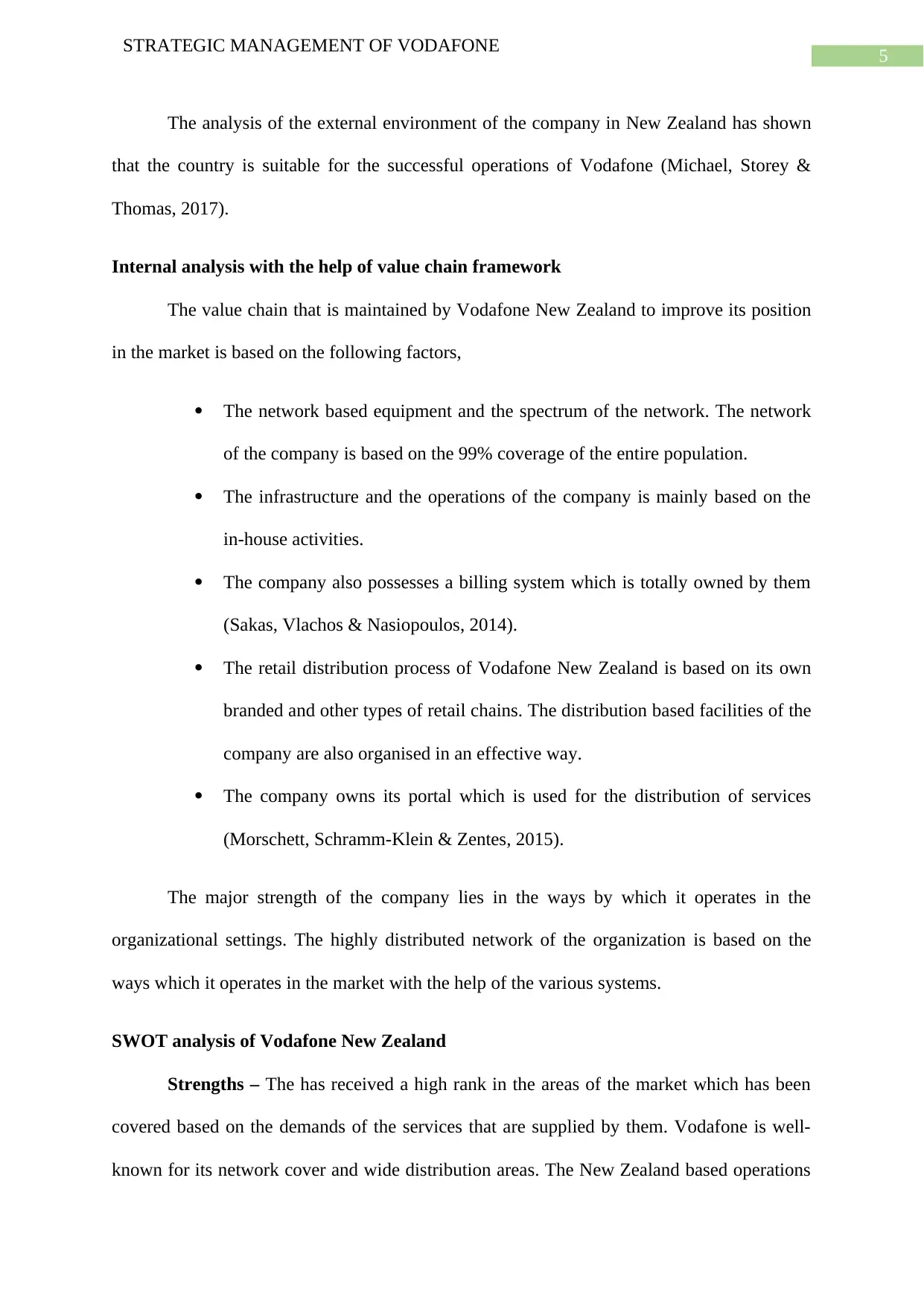
5
STRATEGIC MANAGEMENT OF VODAFONE
The analysis of the external environment of the company in New Zealand has shown
that the country is suitable for the successful operations of Vodafone (Michael, Storey &
Thomas, 2017).
Internal analysis with the help of value chain framework
The value chain that is maintained by Vodafone New Zealand to improve its position
in the market is based on the following factors,
The network based equipment and the spectrum of the network. The network
of the company is based on the 99% coverage of the entire population.
The infrastructure and the operations of the company is mainly based on the
in-house activities.
The company also possesses a billing system which is totally owned by them
(Sakas, Vlachos & Nasiopoulos, 2014).
The retail distribution process of Vodafone New Zealand is based on its own
branded and other types of retail chains. The distribution based facilities of the
company are also organised in an effective way.
The company owns its portal which is used for the distribution of services
(Morschett, Schramm-Klein & Zentes, 2015).
The major strength of the company lies in the ways by which it operates in the
organizational settings. The highly distributed network of the organization is based on the
ways which it operates in the market with the help of the various systems.
SWOT analysis of Vodafone New Zealand
Strengths – The has received a high rank in the areas of the market which has been
covered based on the demands of the services that are supplied by them. Vodafone is well-
known for its network cover and wide distribution areas. The New Zealand based operations
STRATEGIC MANAGEMENT OF VODAFONE
The analysis of the external environment of the company in New Zealand has shown
that the country is suitable for the successful operations of Vodafone (Michael, Storey &
Thomas, 2017).
Internal analysis with the help of value chain framework
The value chain that is maintained by Vodafone New Zealand to improve its position
in the market is based on the following factors,
The network based equipment and the spectrum of the network. The network
of the company is based on the 99% coverage of the entire population.
The infrastructure and the operations of the company is mainly based on the
in-house activities.
The company also possesses a billing system which is totally owned by them
(Sakas, Vlachos & Nasiopoulos, 2014).
The retail distribution process of Vodafone New Zealand is based on its own
branded and other types of retail chains. The distribution based facilities of the
company are also organised in an effective way.
The company owns its portal which is used for the distribution of services
(Morschett, Schramm-Klein & Zentes, 2015).
The major strength of the company lies in the ways by which it operates in the
organizational settings. The highly distributed network of the organization is based on the
ways which it operates in the market with the help of the various systems.
SWOT analysis of Vodafone New Zealand
Strengths – The has received a high rank in the areas of the market which has been
covered based on the demands of the services that are supplied by them. Vodafone is well-
known for its network cover and wide distribution areas. The New Zealand based operations
⊘ This is a preview!⊘
Do you want full access?
Subscribe today to unlock all pages.

Trusted by 1+ million students worldwide
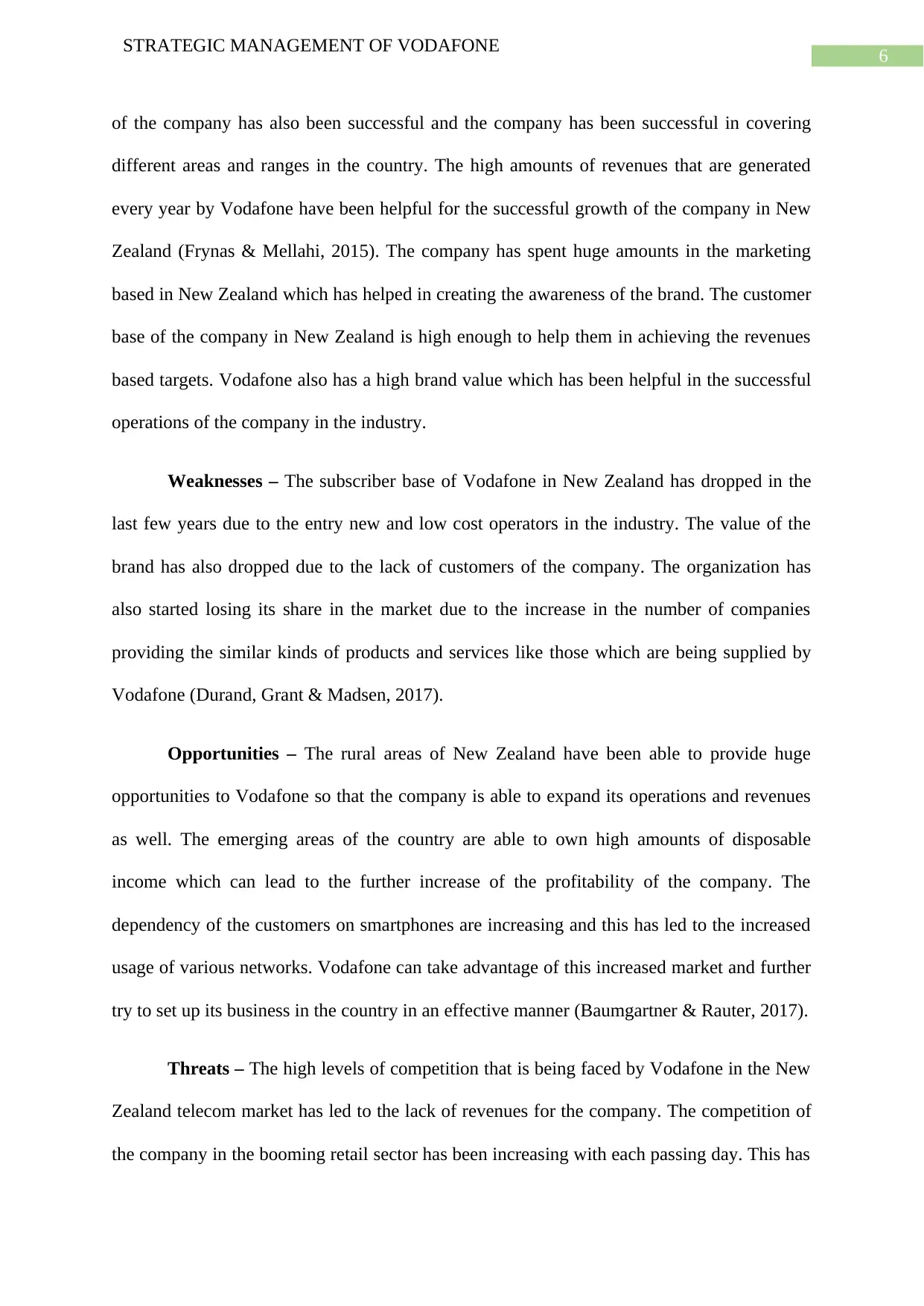
6
STRATEGIC MANAGEMENT OF VODAFONE
of the company has also been successful and the company has been successful in covering
different areas and ranges in the country. The high amounts of revenues that are generated
every year by Vodafone have been helpful for the successful growth of the company in New
Zealand (Frynas & Mellahi, 2015). The company has spent huge amounts in the marketing
based in New Zealand which has helped in creating the awareness of the brand. The customer
base of the company in New Zealand is high enough to help them in achieving the revenues
based targets. Vodafone also has a high brand value which has been helpful in the successful
operations of the company in the industry.
Weaknesses – The subscriber base of Vodafone in New Zealand has dropped in the
last few years due to the entry new and low cost operators in the industry. The value of the
brand has also dropped due to the lack of customers of the company. The organization has
also started losing its share in the market due to the increase in the number of companies
providing the similar kinds of products and services like those which are being supplied by
Vodafone (Durand, Grant & Madsen, 2017).
Opportunities – The rural areas of New Zealand have been able to provide huge
opportunities to Vodafone so that the company is able to expand its operations and revenues
as well. The emerging areas of the country are able to own high amounts of disposable
income which can lead to the further increase of the profitability of the company. The
dependency of the customers on smartphones are increasing and this has led to the increased
usage of various networks. Vodafone can take advantage of this increased market and further
try to set up its business in the country in an effective manner (Baumgartner & Rauter, 2017).
Threats – The high levels of competition that is being faced by Vodafone in the New
Zealand telecom market has led to the lack of revenues for the company. The competition of
the company in the booming retail sector has been increasing with each passing day. This has
STRATEGIC MANAGEMENT OF VODAFONE
of the company has also been successful and the company has been successful in covering
different areas and ranges in the country. The high amounts of revenues that are generated
every year by Vodafone have been helpful for the successful growth of the company in New
Zealand (Frynas & Mellahi, 2015). The company has spent huge amounts in the marketing
based in New Zealand which has helped in creating the awareness of the brand. The customer
base of the company in New Zealand is high enough to help them in achieving the revenues
based targets. Vodafone also has a high brand value which has been helpful in the successful
operations of the company in the industry.
Weaknesses – The subscriber base of Vodafone in New Zealand has dropped in the
last few years due to the entry new and low cost operators in the industry. The value of the
brand has also dropped due to the lack of customers of the company. The organization has
also started losing its share in the market due to the increase in the number of companies
providing the similar kinds of products and services like those which are being supplied by
Vodafone (Durand, Grant & Madsen, 2017).
Opportunities – The rural areas of New Zealand have been able to provide huge
opportunities to Vodafone so that the company is able to expand its operations and revenues
as well. The emerging areas of the country are able to own high amounts of disposable
income which can lead to the further increase of the profitability of the company. The
dependency of the customers on smartphones are increasing and this has led to the increased
usage of various networks. Vodafone can take advantage of this increased market and further
try to set up its business in the country in an effective manner (Baumgartner & Rauter, 2017).
Threats – The high levels of competition that is being faced by Vodafone in the New
Zealand telecom market has led to the lack of revenues for the company. The competition of
the company in the booming retail sector has been increasing with each passing day. This has
Paraphrase This Document
Need a fresh take? Get an instant paraphrase of this document with our AI Paraphraser
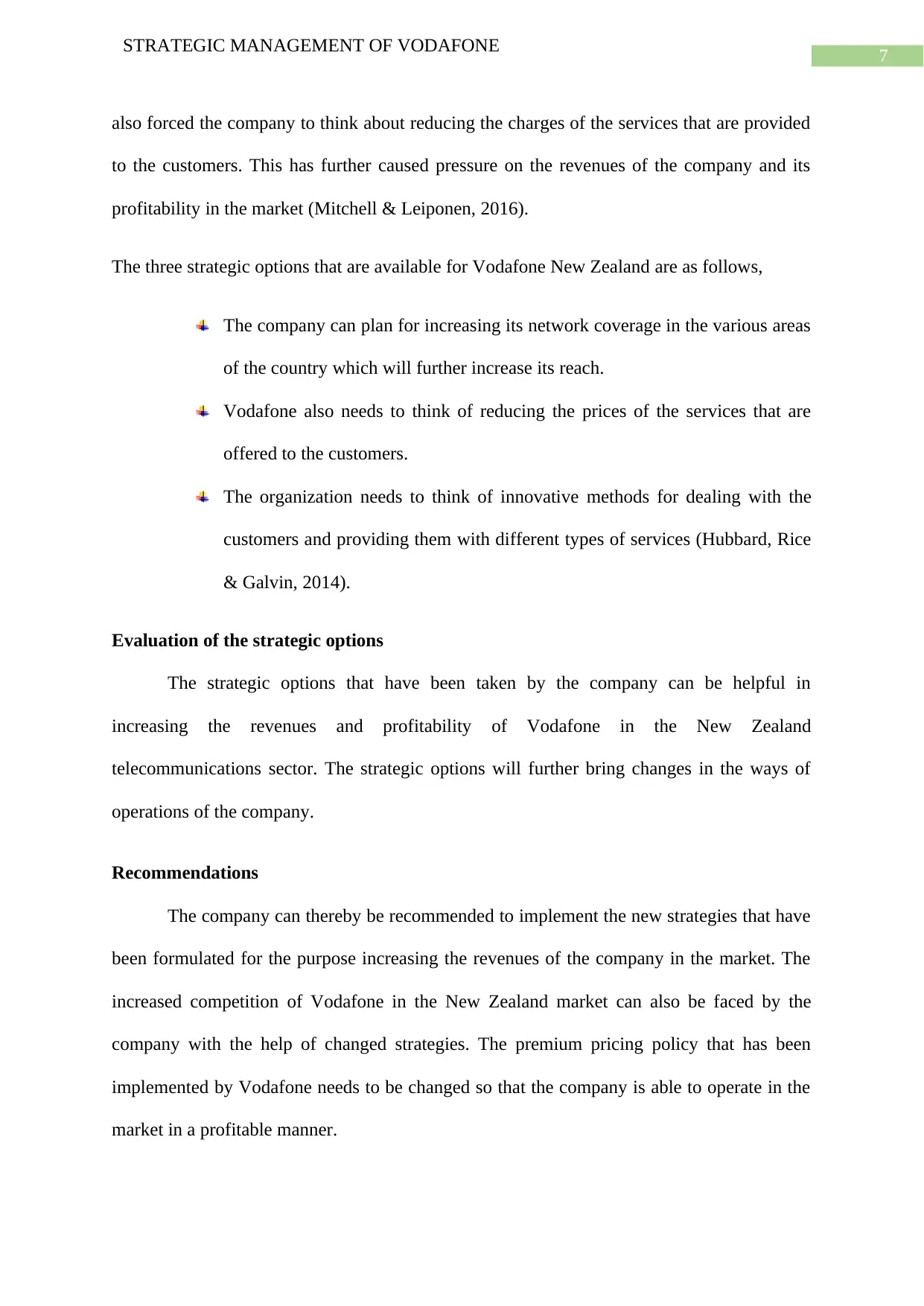
7
STRATEGIC MANAGEMENT OF VODAFONE
also forced the company to think about reducing the charges of the services that are provided
to the customers. This has further caused pressure on the revenues of the company and its
profitability in the market (Mitchell & Leiponen, 2016).
The three strategic options that are available for Vodafone New Zealand are as follows,
The company can plan for increasing its network coverage in the various areas
of the country which will further increase its reach.
Vodafone also needs to think of reducing the prices of the services that are
offered to the customers.
The organization needs to think of innovative methods for dealing with the
customers and providing them with different types of services (Hubbard, Rice
& Galvin, 2014).
Evaluation of the strategic options
The strategic options that have been taken by the company can be helpful in
increasing the revenues and profitability of Vodafone in the New Zealand
telecommunications sector. The strategic options will further bring changes in the ways of
operations of the company.
Recommendations
The company can thereby be recommended to implement the new strategies that have
been formulated for the purpose increasing the revenues of the company in the market. The
increased competition of Vodafone in the New Zealand market can also be faced by the
company with the help of changed strategies. The premium pricing policy that has been
implemented by Vodafone needs to be changed so that the company is able to operate in the
market in a profitable manner.
STRATEGIC MANAGEMENT OF VODAFONE
also forced the company to think about reducing the charges of the services that are provided
to the customers. This has further caused pressure on the revenues of the company and its
profitability in the market (Mitchell & Leiponen, 2016).
The three strategic options that are available for Vodafone New Zealand are as follows,
The company can plan for increasing its network coverage in the various areas
of the country which will further increase its reach.
Vodafone also needs to think of reducing the prices of the services that are
offered to the customers.
The organization needs to think of innovative methods for dealing with the
customers and providing them with different types of services (Hubbard, Rice
& Galvin, 2014).
Evaluation of the strategic options
The strategic options that have been taken by the company can be helpful in
increasing the revenues and profitability of Vodafone in the New Zealand
telecommunications sector. The strategic options will further bring changes in the ways of
operations of the company.
Recommendations
The company can thereby be recommended to implement the new strategies that have
been formulated for the purpose increasing the revenues of the company in the market. The
increased competition of Vodafone in the New Zealand market can also be faced by the
company with the help of changed strategies. The premium pricing policy that has been
implemented by Vodafone needs to be changed so that the company is able to operate in the
market in a profitable manner.

8
STRATEGIC MANAGEMENT OF VODAFONE
STRATEGIC MANAGEMENT OF VODAFONE
⊘ This is a preview!⊘
Do you want full access?
Subscribe today to unlock all pages.

Trusted by 1+ million students worldwide
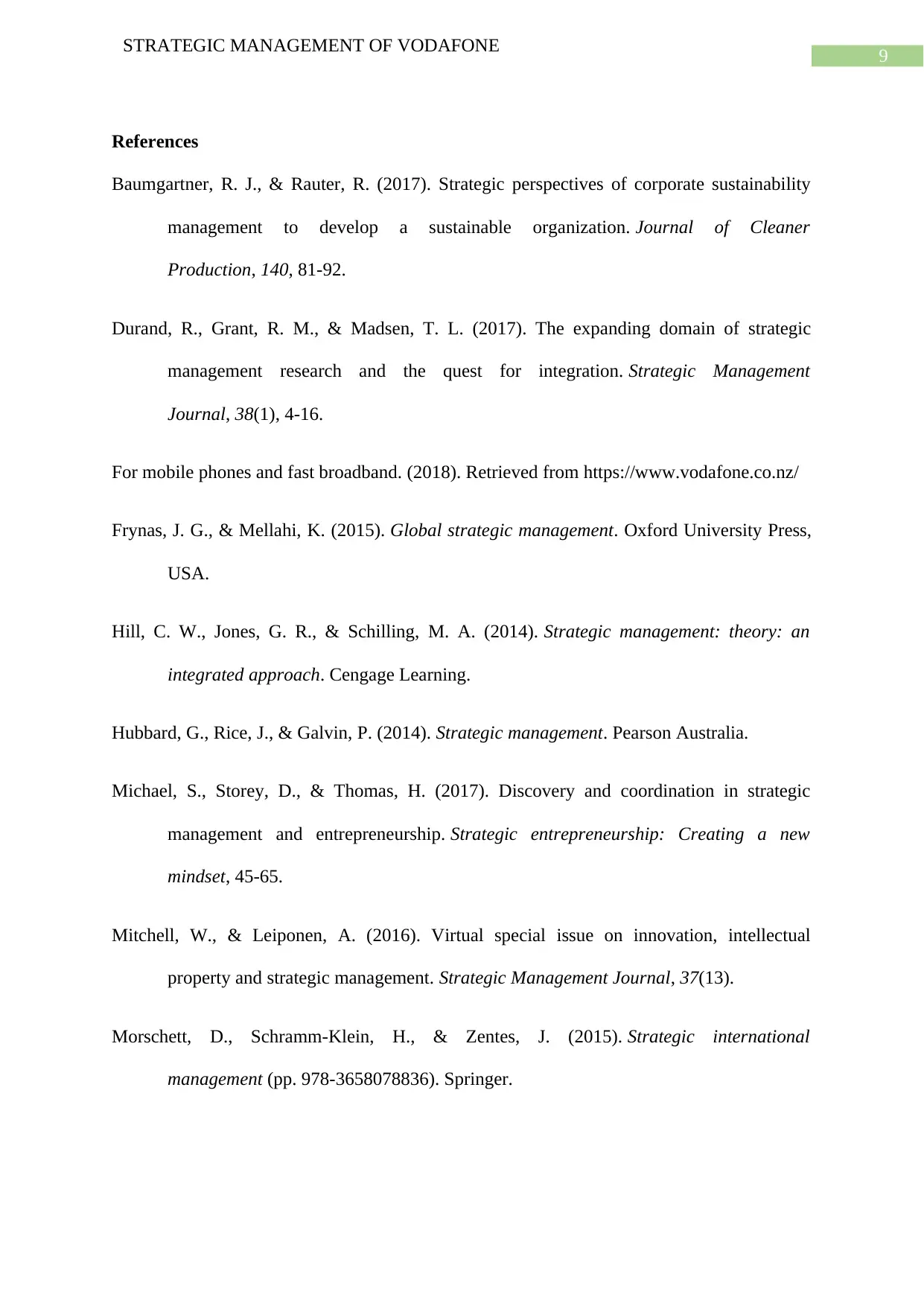
9
STRATEGIC MANAGEMENT OF VODAFONE
References
Baumgartner, R. J., & Rauter, R. (2017). Strategic perspectives of corporate sustainability
management to develop a sustainable organization. Journal of Cleaner
Production, 140, 81-92.
Durand, R., Grant, R. M., & Madsen, T. L. (2017). The expanding domain of strategic
management research and the quest for integration. Strategic Management
Journal, 38(1), 4-16.
For mobile phones and fast broadband. (2018). Retrieved from https://www.vodafone.co.nz/
Frynas, J. G., & Mellahi, K. (2015). Global strategic management. Oxford University Press,
USA.
Hill, C. W., Jones, G. R., & Schilling, M. A. (2014). Strategic management: theory: an
integrated approach. Cengage Learning.
Hubbard, G., Rice, J., & Galvin, P. (2014). Strategic management. Pearson Australia.
Michael, S., Storey, D., & Thomas, H. (2017). Discovery and coordination in strategic
management and entrepreneurship. Strategic entrepreneurship: Creating a new
mindset, 45-65.
Mitchell, W., & Leiponen, A. (2016). Virtual special issue on innovation, intellectual
property and strategic management. Strategic Management Journal, 37(13).
Morschett, D., Schramm-Klein, H., & Zentes, J. (2015). Strategic international
management (pp. 978-3658078836). Springer.
STRATEGIC MANAGEMENT OF VODAFONE
References
Baumgartner, R. J., & Rauter, R. (2017). Strategic perspectives of corporate sustainability
management to develop a sustainable organization. Journal of Cleaner
Production, 140, 81-92.
Durand, R., Grant, R. M., & Madsen, T. L. (2017). The expanding domain of strategic
management research and the quest for integration. Strategic Management
Journal, 38(1), 4-16.
For mobile phones and fast broadband. (2018). Retrieved from https://www.vodafone.co.nz/
Frynas, J. G., & Mellahi, K. (2015). Global strategic management. Oxford University Press,
USA.
Hill, C. W., Jones, G. R., & Schilling, M. A. (2014). Strategic management: theory: an
integrated approach. Cengage Learning.
Hubbard, G., Rice, J., & Galvin, P. (2014). Strategic management. Pearson Australia.
Michael, S., Storey, D., & Thomas, H. (2017). Discovery and coordination in strategic
management and entrepreneurship. Strategic entrepreneurship: Creating a new
mindset, 45-65.
Mitchell, W., & Leiponen, A. (2016). Virtual special issue on innovation, intellectual
property and strategic management. Strategic Management Journal, 37(13).
Morschett, D., Schramm-Klein, H., & Zentes, J. (2015). Strategic international
management (pp. 978-3658078836). Springer.
Paraphrase This Document
Need a fresh take? Get an instant paraphrase of this document with our AI Paraphraser

10
STRATEGIC MANAGEMENT OF VODAFONE
Sakas, D., Vlachos, D., & Nasiopoulos, D. (2014). Modelling strategic management for the
development of competitive advantage, based on technology. Journal of Systems and
Information Technology, 16(3), 187-209.
Steinbach, A. L., Holcomb, T. R., Holmes, R. M., Devers, C. E., & Cannella, A. A. (2017).
Top management team incentive heterogeneity, strategic investment behavior, and
performance: A contingency theory of incentive alignment. Strategic Management
Journal, 38(8), 1701-1720.
Wheelen, T. L., Hunger, J. D., Hoffman, A. N., & Bamford, C. E. (2017). Strategic
management and business policy. pearson.
STRATEGIC MANAGEMENT OF VODAFONE
Sakas, D., Vlachos, D., & Nasiopoulos, D. (2014). Modelling strategic management for the
development of competitive advantage, based on technology. Journal of Systems and
Information Technology, 16(3), 187-209.
Steinbach, A. L., Holcomb, T. R., Holmes, R. M., Devers, C. E., & Cannella, A. A. (2017).
Top management team incentive heterogeneity, strategic investment behavior, and
performance: A contingency theory of incentive alignment. Strategic Management
Journal, 38(8), 1701-1720.
Wheelen, T. L., Hunger, J. D., Hoffman, A. N., & Bamford, C. E. (2017). Strategic
management and business policy. pearson.

11
STRATEGIC MANAGEMENT OF VODAFONE
Appendices
Appendix 1
Appendix 2
STRATEGIC MANAGEMENT OF VODAFONE
Appendices
Appendix 1
Appendix 2
⊘ This is a preview!⊘
Do you want full access?
Subscribe today to unlock all pages.

Trusted by 1+ million students worldwide
1 out of 12
Related Documents
Your All-in-One AI-Powered Toolkit for Academic Success.
+13062052269
info@desklib.com
Available 24*7 on WhatsApp / Email
![[object Object]](/_next/static/media/star-bottom.7253800d.svg)
Unlock your academic potential
Copyright © 2020–2025 A2Z Services. All Rights Reserved. Developed and managed by ZUCOL.



